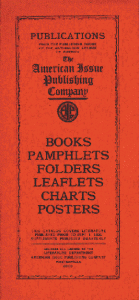In the late 19th Century, during the United States’ Progressive Era, the alcohol industry was booming with production. The use of the railroad system and new technologies allowed breweries to sell beer on a regional and national level. Eventually, competition developed between local breweries and those that shipped goods by train. This then caused business firms to expand the number of saloons in the United States in order to keep up with the competition. As a result, gambling, prostitution, and political power of the saloon increased dramatically.
The Temperance Movement began with a number of organizations’ desire to lower the amount of alcohol consumption of Americans and the political power of the saloon. However, some believed the best way to do this was to cut off the sale and consumption of alcohol completely while others argued for citizens to merely pay more attention to their drinking habits. Organizations such as the Prohibition Party and the Woman’s Christian Temperance Union failed to make any large impact on Congress because of this struggle.
It was not until 1893 when Howard Russell, a lawyer and congregational minister, formed the Anti-Saloon League in Ohio. Russell and his followers formed the organization with different departments dedicated to coordinating events, campaigns and outreach. By the beginning of the 20th century, the Anti-Saloon League had become a nationwide organization. This was partially due to the agitation department of the league which was dedicated to spreading propaganda and educational materials. It eventually created a magazine known as The American Issue as well.
The propaganda of the Anti-Saloon League from 1900-1920 was a large influence on gathering, influencing and keeping members. The books, fliers, pamphlets, and posters of The American Issue Publishing Company first came out of Columbus, Ohio. The publication headquarters then moved to Chicago, and afterwards to Westerville, Ohio at the height of the American Anti-Saloon League’s campaign. Throughout my research I have discovered that the propaganda was tailored towards woman, children and families. Quite a few examples argued for the safety of children, the support of young men or sons fighting in WWI, and stopping the industrialization and political power of the saloon. This can be seen below:
The American Issue included a lot of the Anti-Saloon League’s political standpoints and why it believed alcohol should have been banned. The first issue was published by Howard Russell himself in November of 1893. States began to develop their own publications of the magazine in 1907 and by 1915 the magazine included monthly, weekly, and daily issues. In 1920, the same year the Eighteenth Amendment went into effect, The American Issue Publishing Company produced over one million copies.
It was through this propaganda and the efforts of the Anti-Saloon League that allowed for the 18th amendment to be passed; ending the production, transportation and sale of alcohol.






Click on the gallery page to see more historical publications and propaganda from the prohibition era!